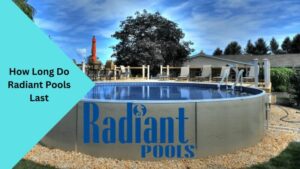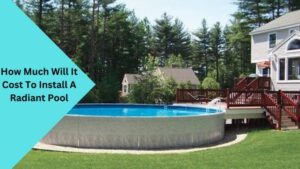Are you considering installing a radiant pool but are unsure about the cost? Look no further! In this comprehensive guide, we will explore the factors that affect the installation cost of a radiant pool, the incredible benefits it offers, and much more. We’ll also address related questions such as how long radiant pools last, the most cost-effective pool to install, and the maximum depth a radiant pool can reach. By the end of this blog post, you’ll have all the information you need to make an informed decision. Let’s dive in!
Factors Affecting the Cost of Installing a Radiant Pool
Installing a radiant pool involves various factors that can influence the cost. By considering these aspects, you can better estimate the overall expenses and make a decision that aligns with your budget. Here’s what you should keep in mind:
- Pool Size: The size of the pool is a major determinant of the installation cost. Larger pools require more material, labor, and excavation, resulting in higher expenses. Conversely, smaller pools tend to be more cost-effective.
- Pool Shape and Design: The shape and design of the pool can impact the installation cost. Pools with intricate shapes or additional features like waterfalls or slides usually require more resources and expertise.
- Ground Condition and Preparation: The condition of the ground where the pool will be installed can affect the overall cost. If the ground requires extensive preparation, such as clearing trees or removing rocks, additional expenses may be incurred.
- Access to the Installation Area: Easy access to the installation area allows for smoother and quicker installation, potentially reducing costs. However, if the location poses challenges for equipment access or requires specialized techniques, it could lead to higher expenses.
- Chosen Pool Contractor: The expertise and reputation of the pool contractor can influence the installation cost. More experienced and reputable contractors may charge higher fees, but they also tend to provide better quality workmanship and customer service.
- Additional Features and Accessories: Optional features and accessories like lighting, heating systems, or pool covers can add to the total cost. Consider your preferences and requirements when deciding which extras, if any, are worth the investment.
By considering these factors, you can better estimate the cost of installing a radiant pool. Next, let’s delve into the remarkable benefits that make radiant pools an excellent choice.
The Benefits of Radiant Pools
Radiant pools offer a range of benefits that make them an attractive option for homeowners looking to enhance their outdoor space. Here are some key advantages of choosing a radiant pool:
- Durability: Radiant pools are constructed using advanced materials, such as structurally insulated panels (SIPs), which provide exceptional strength and durability. These pools can withstand harsh weather conditions, including extreme temperatures and ground movement.
- Energy Efficiency: The insulation properties of SIPs used in radiant pools help regulate the water temperature and reduce heat loss. This energy-efficient design can lead to considerable savings on heating costs, making radiant pools a cost-effective choice in the long run.
- Quick Installation: Unlike traditional in-ground pools, radiant pools can be installed relatively quickly. The use of pre-engineered components streamlines the installation process, minimizing construction time and disruption to your property.
- Versatility in Design: Radiant pools offer versatile design options, allowing you to tailor the pool to your preferences and space requirements. From rectangular shapes to freeform designs, there’s a wide range of possibilities to suit your aesthetic preferences.
- Saltwater Compatibility: Many radiant pools are compatible with saltwater systems, offering a more natural and gentle swimming experience. Saltwater pools have lower chemical maintenance needs compared to traditional chlorine pools, providing a more eco-friendly alternative.
- Low Maintenance: The durable materials and innovative design of radiant pools contribute to their low maintenance requirements. Unlike traditional pools, radiant pools have a reduced risk of leaks or cracks, saving you time and money on repairs in the long term.
Now that we’ve explored the benefits of radiant pools, let’s address one common concern – the lifespan of these pools.
How Long Do Radiant Pools Last?

Radiant pools are known for their exceptional longevity, providing homeowners with years of enjoyment. The durability of these pools can be attributed to their construction and materials. On average, a radiant pool can last between 30 to 50 years or even longer with proper maintenance and care.
The key factors that contribute to the long lifespan of radiant pools are:
- Robust Construction: Radiant pools are built using structurally insulated panels (SIPs), which offer superior structural integrity compared to traditional pool materials. The combination of aluminum, foam, and polystyrene creates a durable barrier that can withstand the test of time.
- Resistance to Weather and Ground Movement: Unlike conventional pools, radiant pools are engineered to handle extreme weather conditions and ground movement. The SIPs used in their construction provide flexibility and strength, minimizing the risk of damage.
- Minimal Exposure to Harsh Chemicals: Radiant pools have a unique design that reduces the exposure of the pool structure to harsh chemicals. This design helps preserve the materials and prevents premature degradation, resulting in a longer lifespan.
To ensure your radiant pool achieves its maximum lifespan, it’s important to follow regular maintenance and care guidelines provided by the manufacturer. Proper chemical balancing, routine cleaning, and protecting the pool from extreme weather conditions will help extend its longevity.
Next, let’s address the cost-effectiveness of radiant pools compared to other pool options.
Also Read our comperhansive Details article about Can Fiberglass Pools Be Installed Above Ground? All Your Questions Answered.
What Is the Most Cost-Effective Pool to Install?
When it comes to cost-effectiveness, radiant pools outshine many traditional pool options. Factors that contribute to the cost-efficiency of radiant pools include:
- Lower Installation Cost: Compared to traditional in-ground pools, radiant pools are often more affordable to install. The efficient use of materials and the streamlined installation process can result in cost savings.
- Energy Efficiency: Radiant pools are designed with energy efficiency in mind. The insulation properties of SIPs help regulate the water temperature, reducing the need for excessive heating. This translates to lower energy costs over time.
- Reduced Maintenance: The durability and low-maintenance nature of radiant pools can save you money in the long term. With fewer repairs and replacements needed, you’ll spend less on upkeep and more time enjoying your pool.
- Long Lifespan: As mentioned earlier, radiant pools have an impressive lifespan of 30 to 50 years or more. Choosing a pool that lasts longer reduces the need for frequent replacements, making radiant pools a cost-effective option.
While upfront costs may vary based on factors such as pool size and additional features, the long-term savings associated with radiant pools make them a wise investment.
Now, let’s address another important aspect of installing a radiant pool – its maximum depth.
How Deep Can a Radiant Pool Be?
Radiant pools offer flexibility in terms of depth, allowing you to customize the pool according to your preferences and needs. The maximum depth of a radiant pool depends on the specific model and its engineering specifications. However, radiant pools can be designed to reach depths suitable for various activities, such as diving or water sports.
When discussing the desired depth for your radiant pool, consider the following factors:
- Safety: Ensure that the depth you choose complies with safety regulations and guidelines. If you have young children or inexperienced swimmers, you may want to opt for a shallower pool to minimize risks.
- Purpose: Determine the primary use of your pool. If you enjoy diving or want to accommodate specific water activities, a deeper pool may be more suitable. However, if relaxation and wading are your priorities, a shallower pool can still provide an enjoyable experience.
- Location and Space: Assess the available space for your pool installation and consider any restrictions imposed by local authorities. These factors may influence the maximum depth you can achieve.
Consulting with a professional pool contractor or reading the specifications provided by the radiant pool manufacturer is crucial to determine the maximum depth of the specific model you choose. They can assess your requirements, the available space, and safety considerations to recommend an appropriate depth for your radiant pool.
Conclusion
In conclusion, radiant pools offer an excellent option for homeowners looking to install a durable, energy-efficient, and cost-effective swimming pool. By considering factors such as pool size, shape, ground condition, and access to the installation area, you can estimate the overall cost of installing a radiant pool.
Beyond the cost, radiant pools provide an array of benefits, including durability, energy efficiency, quick installation, versatile design options, saltwater compatibility, and low maintenance requirements. With proper care, radiant pools can last anywhere from 30 to 50 years or more, making them a long-lasting investment.
When comparing the cost-effectiveness, radiant pools outperform many traditional pool options due to their lower installation costs, energy efficiency, reduced maintenance, and long lifespan.
Additionally, radiant pools offer flexibility in terms of depth, allowing you to customize the pool to your desired specifications and preferences, while adhering to safety guidelines.
Now that you have a comprehensive understanding of radiant pools and their installation cost, benefits, longevity, cost-effectiveness, and depth options, it’s time to take the next step. Reach out to a reputable pool contractor in your area to discuss your specific requirements and transform your backyard into an oasis with a stunning radiant pool.
Don’t miss out on the opportunity to enhance your outdoor living space and enjoy countless memorable moments in your very own radiant pool. Invest in a radiant pool today and create a haven of relaxation and fun for years to come!

Greetings, fellow pool enthusiasts! I’m Turner Davis, your dedicated guide to the world of pool care and maintenance. With over a decade of experience in the field, I’ve made it my mission to transform ordinary pools into extraordinary aquatic retreats.

